Enticing Solitary Bees or Bumblebees to Live in Your Garden
By Sy Maher
Inviting solitary bees to live in your yard is beneficial and fun. Solitary Bees almost never sting. You really have to annoy a native bee to get them defensive.
Solitary bees have a short life cycle. For instance, the Mason bees come out in early spring, pollinates, makes its babies, and dies off in six weeks. They leave behind larvae in cocoons that survives the queen. Then the leafcutter bees take over in summer. They do the same thing. Pollinate (get food and nectar) the queen makes babies then dies in six to eight weeks.
Bumblebees do nearly the same thing except it is a new queen that is left behind, not eggs. She fattens up for the winter to stay alive. When spring finally comes the new queen awakens, seeks out a new nest, lays her eggs to start a new brood of workers and drones.
As bee lovers, we can support wild bees in our gardens by providing them with food and shelter.
Wild bee hotels can be very rustic looking or accommodate other beneficial insects,

Elaborate looking,
![By KläuschenClara (Own work) [CC BY-SA 3.0 (https://creativecommons.org/licenses/by-sa/3.0)], via Wikimedia Commons](https://luckeybee.com/wp-content/uploads/2017/11/Hotel_for_wild_bees_and_insects.jpg)
or Whimsical.

Getting a bumblebee to take up residence in your yard takes a little more work. Their favorite place is a long-vacant rodent burrow, while other species like nest above ground, such as an old tree, in thick grass, or in tree holes.
Below is an excellent video that may help get bumblebees into your garden.
Be hotels can be made from materials lying around. Have fun with children making these beneficial homes or use them as projects for the classroom. Bees pollinate your veggies and flowers and it’s enjoyable to watch them work.They may even be that perfect Christmas gift.
Sources
Bee Gardens Can Help Save Bees in the Greater Mesa/Phoenix Area
https://commons.wikimedia.org/wiki/Category:Photographs


